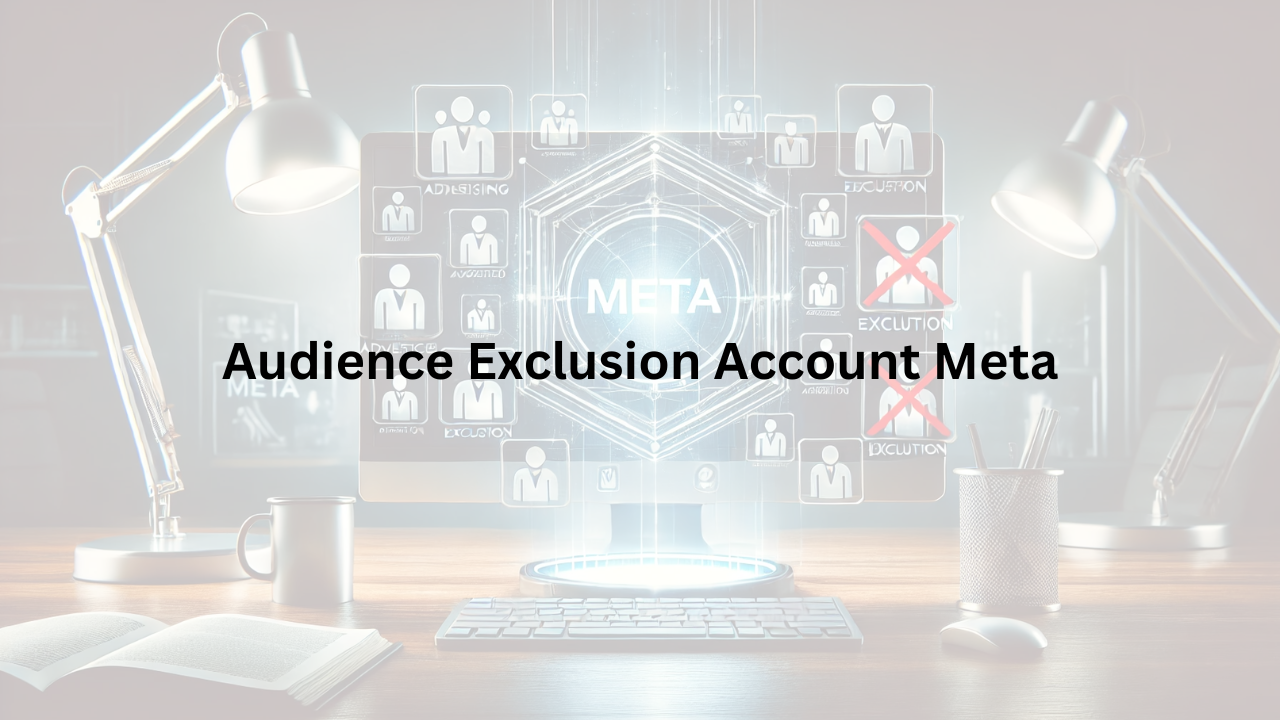Introduction : Audience Exclusion Account Meta
In Meta advertising, audience exclusion is a tool that helps advertisers show their ads to the right people. It allows them to avoid displaying ads to users who are unlikely to be interested. This ensures that ads reach those who are more likely to respond positively.
Definition and Purpose of Audience Exclusion
Audience exclusion means choosing not to show ads to certain groups of people. For example, if a business sells products only in Lahore, they can exclude people who live outside Lahore from seeing their ads. This helps in focusing the advertising efforts on the most relevant audience.
Importance of Audience Exclusion in Targeted Advertising
Using audience exclusion is important because it helps businesses save money by not showing ads to people who are unlikely to be interested. This means the advertising budget is used more effectively, reaching only those who are potential customers. By excluding certain audiences, businesses can make sure their ads are seen by the right people, leading to better results.
Benefits of Audience Exclusion in Meta Advertising
| Benefit | Description |
|---|---|
| Cost Efficiency | Saves money by not showing ads to uninterested users. |
| Improved Ad Performance | Increases chances of engagement by targeting the right audience. |
| Enhanced Relevance | Ensures ads are shown to people who are more likely to be interested. |
| Better Resource Allocation | Focuses marketing efforts on potential customers. |
Recent Changes to Audience Exclusion Account Meta
Meta has recently updated its advertising platform by removing detailed targeting exclusions. This change affects how advertisers manage their audience exclusion account meta settings.
Overview of the Phased Removal of Detailed Targeting Exclusions
Previously, advertisers could exclude specific groups from their ad campaigns using detailed targeting exclusions. Meta found that removing these exclusions improved ad performance. As a result, they decided to phase out this feature.
Timeline of the Changes Implemented by Meta
- Initial Announcements and Accidental Alerts In May 2024, some advertisers received alerts stating that detailed targeting exclusions would be removed by June 28, 2024. Meta later clarified that these alerts were sent in error and that no immediate changes were planned at that time.
- Official Removal Dates and Grace Periods In June 2024, Meta officially announced the removal of detailed targeting exclusions for new ad campaigns. Existing campaigns using these exclusions remained unaffected until January 31, 2025. After this date, such campaigns would stop delivering ads, and advertisers would see warning banners in their accounts.
Key Dates in Meta Audience Exclusion Changes
| Date | Event |
|---|---|
| May 2024 | Accidental alerts about removal sent to advertisers |
| June 2024 | Official announcement of removal for new campaigns |
| January 31, 2025 | End of grace period; existing campaigns with exclusions stop delivering ads |
These changes in audience exclusion account meta settings mean advertisers need to adjust their strategies. Alternative methods, like custom audience exclusions and account-level audience controls, are still available to manage who sees their ads.
Reasons Behind Meta Decision
Meta has recently changed its advertising approach by removing detailed targeting exclusions. This decision impacts how advertisers manage their audience exclusion account meta settings. Let’s explore the reasons behind this change.
Advancements in AI-Driven Targeting Systems
Meta’s advertising platform now uses advanced artificial intelligence (AI) to show ads to the right people at the right time. This AI system has become very good at understanding who might be interested in an ad. Because of this improvement, the need for manual audience exclusions has decreased. Meta believes that their AI can handle targeting more effectively without detailed exclusions.
Internal Research Findings on Campaign Performance
Meta conducted studies to see how removing detailed targeting exclusions would affect ad performance. They found that when these exclusions were removed, the median cost per conversion decreased by 22.6%. This means that ads became more cost-effective, reaching interested users without the need for manual exclusions. Based on these findings, Meta decided to rely more on their AI-driven systems for ad targeting.
Impact of Removing Detailed Targeting Exclusions
| Metric | Before Removal | After Removal | Improvement |
|---|---|---|---|
| Median Cost per Conversion | Higher | 22.6% Lower | Yes |
Implications for Advertisers
Meta’s removal of detailed targeting exclusions affects how advertisers manage their audience exclusion account meta settings. Let’s explore the effects on advertising campaigns and alternative exclusion options available.
Effects on Existing and New Advertising Campaigns
For new advertising campaigns, detailed targeting exclusions are no longer available. This means advertisers cannot exclude specific audience segments as they did before. Existing campaigns using these exclusions will continue until January 31, 2025. After this date, such campaigns will stop delivering ads, and advertisers will see warning banners in their accounts.
Alternative Exclusion Options Available
Despite the removal of detailed targeting exclusions, advertisers still have methods to control who sees their ads.
- Custom Audience Exclusions Advertisers can create custom audiences to exclude specific groups. For example, they can upload a list of existing customers to prevent them from seeing certain ads. This ensures ads reach new potential customers instead of those already familiar with the brand.
- Account-Level Audience Controls Meta provides account-level controls that allow advertisers to manage exclusions across all campaigns. This feature helps maintain brand safety by preventing ads from appearing to unwanted audiences. By setting these controls, advertisers can ensure their ads are shown only to relevant users.
Comparison of Audience Exclusion Methods
| Method | Description |
|---|---|
| Custom Audience Exclusions | Upload lists to exclude specific groups, like existing customers. |
| Account-Level Controls | Set rules at the account level to manage exclusions across all campaigns. |
Strategies for Adapting to Audience Exclusion Account Meta Changes
Meta has updated its advertising platform, affecting how advertisers manage their audience exclusion account meta settings. To succeed in this new environment, consider the following strategies:
Embracing AI-Driven Targeting Approaches
Meta’s AI tools, like Meta Advantage+, help show ads to the right people. These tools use smart audience data to find and predict who might be interested in your ads. By using these AI-driven methods, advertisers can improve their campaigns and reach the best audience.
Utilizing Alternative Exclusion Methods Effectively
Even though detailed targeting exclusions are gone, advertisers can still control who sees their ads:
- Custom Audience Exclusions Create custom lists to exclude certain groups, like current customers, so your ads reach new people.
- Account-Level Audience Controls Set rules at the account level to manage who sees your ads across all campaigns, helping protect your brand.
Monitoring and Optimizing Campaign Performance in the New Landscape
Keep a close eye on your ad campaigns to see how they’re doing. Use Meta’s tools to track performance and make changes as needed. Regularly check metrics like engagement and conversion rates to ensure your ads are effective.
Key Strategies for Adapting to Meta Changes
| Strategy | Description |
|---|---|
| AI-Driven Targeting | Use Meta’s AI tools to reach the right audience. |
| Custom Audience Exclusions | Exclude specific groups to focus on new customers. |
| Account-Level Audience Controls | Manage who sees your ads across all campaigns. |
| Monitoring and Optimization | Regularly check and adjust your campaigns for better performance. |
Conclusion
Meta has made significant changes to its advertising platform by removing detailed targeting exclusions. This means advertisers can no longer exclude specific audience segments in the same way as before. The goal of this change is to improve ad performance by using advanced AI-driven targeting methods.
To adapt to these changes, advertisers should embrace Meta’s AI tools, like Meta Advantage+, which help deliver ads to the most relevant audiences. Additionally, using alternative exclusion methods, such as custom audience exclusions and account-level audience controls, can help maintain effective targeting. Regularly monitoring and optimizing campaign performance is also essential to ensure success in this new advertising environment.
By adjusting strategies to align with Meta’s new approach, advertisers can continue to reach their desired audiences effectively and achieve their marketing goals.



